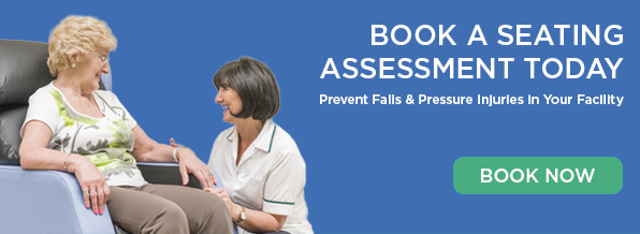Prolonged bed rest and immobility contribute negatively to the physical function, pressure management and quality of life of the patient.
Early mobilization in the earliest days of critical illness has been shown to improve long term outcomes for the patient, decrease re-positioning needs, expedite discharge and reduce re-admissions.
CLICK HERE TO BOOK A SEATING ASSESSMENT
Too often we see an over reliance on bed rest for pressure care management, despite the fact that bed rest can have a detrimental effect on a patient’s health and recovery. The prescription of correct seating may aid early mobilization by supporting the patient to get out of bed earlier and therefore positively impacts their clinical outcome.*
Seating Matters Chairs Encourage Early Mobilization
Semi-Sitting Position
The Seating Matters chairs have been designed to provide postural support, pressure management and assist with re-positioning.
The tilt in space function allows for semi-sitting to be achieved. This refers to a position midway between bed rest and upright sitting. If the patient does not have adequate core strength to maintain an upright position in a standard chair, the Seating Matters chairs are designed to improve their sitting balance and help in the rehabilitation process.
Reduction Healthcare Costs & Pressure Injuries
To expedite your patients’ rehabilitation and recovery you should introduce seating at the earliest stage possible in their treatment. Patients can then be transferred from an Intensive Care Unit (ICU) to a High Dependency Unit (HDU) or Step Down Unit (SDU), this will drastically decrease the cost of this patient to your healthcare system.
If a patient gets a pressure injury, they may be expected to stay in hospital an additional 6.4 days, costing $1,878 / £400 per day.4,6
This financial impact can be detrimental for a facility, but primarily we need to focus on the impact a pressure ulcer can impact a patient’s health and quality of life. In fact, patients with hospital acquired pressure injuries are 7% more likely to die.2
From our clinical research, Seating Matters chairs have proven to help prevent pressure injuries and reduce existing ulcers, therefore speeding up discharge for your patient and reducing the cost to your healthcare budget.¹
Muscle Breakdown
Bed rest results in 12% loss of muscle strength each week, intensifying to 50% loss after 3-5 weeks.3 Therefore, encouraging the patient to sit in a chair as early as possible into their treatment can be a key factor in order to preserve muscle strength.
Early mobilization is the perfect aid to limiting any possible muscle mass breakdown for your patient. It is a tool that can be used to support the rehabilitation process and to help prevent muscle atrophy.
Increased Independence & Improved Health
When a patient is confined to a bed, their ability to do minor tasks is inhibited and can result in cognitive, psychological and physiological complications.
In contrast, early mobilization using the correct chair that fully supports a patient's posture and meets their clinical needs may contribute to their overall health and well-being.
If the chair is accurately prescribed it may contribute to the prevention of the patient sliding or falling and limit manual handling for staff. As a result, the patient can hopefully restore their previous level of independence and ability to complete functional tasks such as reaching for a drink, feeding themselves or reading the newspaper.
Physiologically, a patient's digestion and elimination will also be positively impacted along with the fact that early mobilization aids respiration and increases blood oxygen levels by 10% in 85% of patients, which has numerous health benefits.5
Psychological Well-Being & Speed of Recovery
When a person is lying down, their ability to do even minor tasks is inhibited which can, understandably, lead to a decrease in motivation and have a dramatic impact on recovery. You can imagine the positive impact that all of the improvements generated by sitting out of bed, as mentioned above, can have on the patient's psychological well-being, their dignity and confidence. As a result, they may start to feel better mentally and be more motivated to interact with staff members, family and other patients.
The impact on speed of recovery can be life changing.
Some Key Benefits of Early Mobilization
- Quicker discharge from ICU or High Dependency Units to Step Down Units, reducing healthcare costs.
- Overall health and well-being may be positively impacted.
- Increased functional ability and increased independence.
- Improved approach to pressure management, reducing risk of pressure injuries.
- Maintenance of muscle mass and strength.
- Families and caregivers happier to see their loved one/patient out of bed and sitting comfortably.
- Improved social interaction, communication, inclusion and increased motivation.
Prescribing Therapeutic Seating
A thorough Seating Assessment should be carried out by an Occupational Therapist, Physiotherapist or qualified Seating Specialist to identify the clinical needs, chair function and design required for the person in need. This will ensure that the patient is seated in the correct chair as soon as possible.
The impact of a specialist, individualized seating solution may positively affect the patient's health and well-being. Thorough Seating Assessments & adjustable chairs can keep patients safe and secure, reducing need for time spent in bed, reducing pressure injuries, providing comfort and overall aiding a quicker recovery and a better quality of care and patient outcomes.
CLICK HERE TO BOOK A SEATING ASSESSMENT TO ENHANCE SOMEONE'S LIFE TODAY
References
1. Tierney, M. (2015) The Clinician’s Seating Handbook. 4th Ed. Northern Ireland: Seating Matters.
2. Pham, B., Teague, L., Parslow, N. and Harris, C. (2013) Opinion: Should Ontario be more proactive in pressure ulcer prevention. [Online] Available from: http://healthydebate.ca/author/bpltnpch. [Accessed 7 October 2015].
3. Jiricka, M.K. (2008) Activity tolerance and fatigue pathophysiology: concepts of altered health states. Essentials of Pathophysiology: Concepts of Altered Health States.
4. Lyder, C.H. (2002) Pressure ulcer prevention. Annual Review of Nursing Research, 20. p. 35-61.
5. Daly, O., Casey, J., Martin, S., Tierney, M. & McVey, O. (2013) The effectiveness of specialist seating provision for nursing home residents, Ulster University.
6. Rappleye, E. (2015) Average cost per inpatient day across 50 states. [Online] Available from: https://www.beckershospitalreview.com/finance/average-cost-per-inpatient-day-across-50-states.html [Accessed 7th November 2017].
*Note - the purpose of this blog is to give an overview of the product with some tips to consider on its use. This is not intended to be a substitute for professional or medical advice, diagnosis, prescription or treatment and does not constitute medical or other professional advice. For advice with your personal health or that of someone in your care, consult your doctor or appropriate medical professional.






